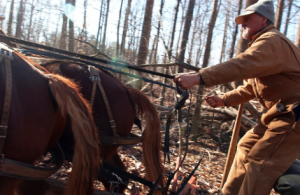The term “Tree Hugger” is synonymous with “Environmental Wacko”. One might say it’s used for environmental profiling.
From the Dictionary on my computer: Tree Hugger is a noun used informally, chiefly derogatory, for an environmental campaigner. I think I fit this description although I believe in harvesting mature trees or weeding out undesirable trees using sound forestry practices.
I believe in harvesting mature trees in a sustainable way; not clear cutting of course but selectively cutting so that a perpetual, unevenly aged forest is constantly growing. A well managed forest can sustain a harvest every ten years. After all, trees are renewable. So, from a silvicultural standpoint, I’m not a tree hugger but in other ways I am.
We should not cut down genetically superior trees or ones that have the genetic traits we seek. That would be like killing the goose that laid the golden eggs. We should also protect trees of remarkable significance such as the tallest, the oldest or ones that have touched us in some way like connecting us to history or a loved one. I am drawn to these trees and will often give them, yes, a hug.
This year I gave two trees a hug, the Lafayette Sycamore in the Brandywine Battlefield of Pennsylvania and the Algernourne Live Oak in Fort Monroe, Virginia. I also reverently picked up a leaf from the famous American Chestnut tree known as the “Thompson” tree in Lesesne State Forest of Nelson County, Virginia. I would have hugged that tree but it’s fenced off to prevent the spread of a soil born pathogen to other American Chestnuts.
The Lafayette Sycamore:
During our War of Independence, the nineteen year old Marquis de LaFayette was wounded in the Battle of Brandywine. Legend has it they brought him to rest under this tree.
The Algernourne Live Oak:
The Algernourne Live Oak is 474 years old. It’s in Fort Monroe, now a National Monument along with 338 other Live Oaks. This tree witnessed the first slaves entering the New World from Africa. The White Lion, a Dutch ship landed here in 1619 when it was called Old Point Comfort.
Fort Monroe, also known as the“Gibraltar of the Chesapeake”, is the largest stone fortress in America, It was built to protect the Chesapeake Bay from invasion by sea. During the Civil War the fort was part of the “underground railroad”. It was a safe haven for runaway slaves because it was a Union stronghold within Virginia – a confederate state. Harriet Tubman worked here and Jefferson Davis, President of the Confederate States of America was imprisoned here after the war.

Dexter watches as I give the Algernourne Live Oak a hug. This tree witnessed the first African slaves on their way to Jamestown in 1619.
The Thompson Tree:
The American Chestnut was the greatest tree in North America. Once the tallest, fastest growing and most dominant tree in the East it was and still is the victim of an invasive fungus from Asia. In perhaps the greatest natural disaster in America these former mighty giants of the forest now become mere stump sprouts that die back after a few years from affects of the fungus – called Chestnut Blight. The American Chestnut Foundation, with 6,000 members has a mission to restore the tree to our eastern forests.
According to some scientists, the “Thompson Tree” is one of the most blight resistant American Chestnuts. It survives in the Lesesne State Forest in Nelson County, Virginia, which is dedicated to American Chestnut research. This tree is steeped in research history. Its roots grew from an irradiated nut during the “Atomic Age” when scientists used radioactive material to cause mutations. Then researchers grafted true American Chestnut “scion” wood onto these roots. Later, researchers infected the tree with “hypovirulent” strains of the fungus to increase the tree’s resistance to the blight. There are thousands of people dedicated to bringing back the American Chestnut; it’s a true marriage of science and passion. I am confident the American Chestnut will someday become part of the Eastern Forests where it once was King of the Forest.
Dr. John Scrivani of the American Chestnut Foundation and my JMU students in front of the Thompson Tree – a historic American Chestnut.






11 Comments
Leave your reply.